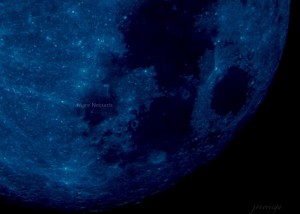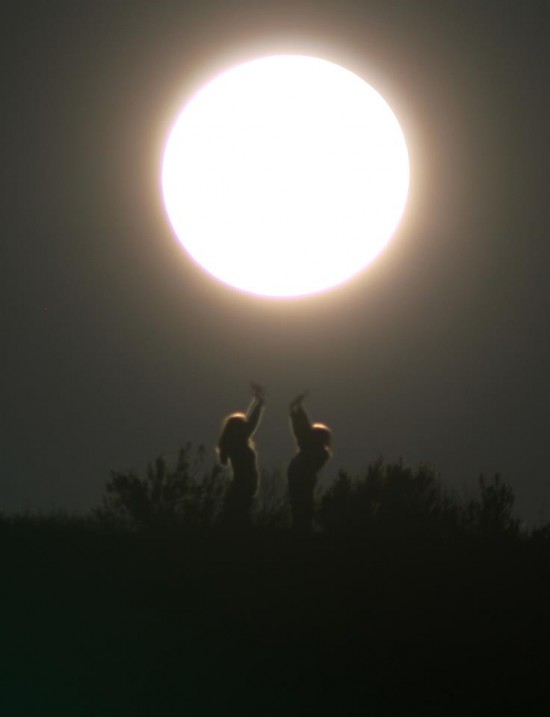The August 31, 2012 full moon is a Blue Moon

Moon shot with blue filter via our friend Jv Noriega
|
|
August 2012 is a month with two full moons. And, by popular acclaim, that means it’s a Blue Moon month – but Blue in name only. That’s because a Blue Moon is sometimes defined as the second full moon in a calendar month. The first full moon was August 1. The second full moon is today – August 31, 2012. The second full moon of August 2012 is the Blue Moon. Happy Blue Moon, everyone!
There are two more definitions for Blue Moon. It can be the third of four full moons in a single season. Or, someday, you might see an actual blue-colored moon.

The August 31 Blue Moon will not be blue in color. This photo was created using special filters. This August 2012 Blue Moon will be called Blue because it is the second full moon of a month. Image via EarthSky Facebook friend Jv Noriega.
It’s very rare that you would see a blue-colored moon, although unusual sky conditions – certain-sized particles of dust or smoke – can create them. Blue-colored moons aren’t predictable. So don’t be misled by the photo above. The sorts of moons people commonly call Blue Moons aren’t usually blue. For more about truly blue-colored moons, click here.
Now on to folklore’s Blue Moons. Every month typically has a full moon (although sometimes February doesn’t). In fact, our word for “month” comes from the word “moon.” Most of the time, the names for full moons coincide with particular months or seasons of the year. So whether you define a Blue Moon as the second full moon in a month – or the third full moon of four in a season – the name Blue Moon accounts for times when there are more full moons than is ordinary.
Blue moon as second full moon in a month. In recent decades, many people have begun using the name Blue Moon to describe the second full moon of a calendar month.
The time between one full moon and the next is close to the length of a calendar month. So the only time one month can have two full moons is when the first full moon happens in the first few days of the month. This happens every 2-3 years, so these sorts of Blue Moons come about that often.
When is the next Blue Moon, according to this first definition? August 31, 2012.

Another beautiful image by our friend Jv Noriega – the moon among fast-moving clouds. Will the August 31 full moon be blue in color like this? No. This image was made using blue filters, too. Thank you, Jv!
The idea of a Blue Moon as the second full moon in a month stemmed from the March 1946 issue of Sky and Telescope magazine, which contained an article called “Once in a Blue Moon” by James Hugh Pruett. Pruett was using a 1937 Maine Farmer’s Almanac, but he simplified the definition. He wrote:
Seven times in 19 years there were — and still are — 13 full moons in a year. This gives 11 months with one full moon each and one with two. This second in a month, so I interpret it, was called Blue Moon.
EarthSky’s Deborah Byrd happened upon a copy of this old 1946 issue of Sky and Telescope in the stacks of the Peridier Library at the University of Texas Astronomy Department in the late 1970s. Afterward, she began using the term Blue Moon to describe the second full moon in a calendar month on the radio. Later, this definition of Blue Moon was also popularized by a book for children by Margot McLoon-Basta and Alice Sigel, called “Kids’ World Almanac of Records and Facts,” published in New York by World Almanac Publications, in 1985. The second-full-moon-in-a-month definition was also used in the board game Trivial Pursuit.
Can there be two blue moons in a single calendar year? Yes. It last happened in 1999. There were two full moons in January and two full moons in March and no full moon in February. So both January and March had Blue Moons.
The next year of double blue moons is coming up in 2018.

What most call a Blue Moon isn't blue in color. It's only Blue in name. This great moon photo from EarthSky Facebook friend Rebecca Lacey in Cambridge, Idaho.
Blue moon as third full moon of four in a season. The Old Farmer’s Almanac defined a Blue Moon as an extra full moon that occurred in a season. One season – winter, spring, fall, summer – typically has three full moons. If a season has four full moons, then the third full moon may be called a Blue Moon.
The next blue moon by this definition will fall on August 21, 2013.
In recent years, a controversy has raged – mainly among purists – about which Blue Moon definition is better. The idea of a Blue Moon as the third of four in a season may be older than the idea of a Blue Moon as the second full moon in a month. Is it better? Is one definition right and the other wrong? After all, this is folklore. So the folk get to decide, and, in the 21st century, both sorts of full moons have been called Blue.
As the folklorist Phillip Hiscock wrote in his comprehensive article Folklore of the Blue Moon:Old folklore it is not, but real folklore it is.
So enjoy Blue Moons!
Bottom line: A blue-colored moon is rare. But folklore has defined two different kinds of Blue Moons. A Blue Moon can be the second full moon in a month. Or it can be the third of four full moons in a season. The full moon of August 31, 2012 will be considered a Blue Moon.